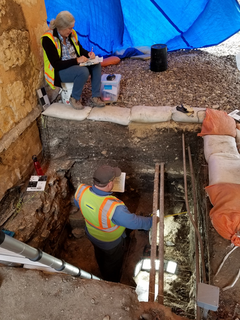Archaeologists from Raba Kistner working on the investigations associated with the architecture investigations have uncovered the base of the Church foundation in three of the five currently working units. On the south side of the Church, on the exterior of the south transept, in the location of the area where the monel plate was installed in 1995, the archeologists revealed that the base of the foundation is approximately 5.6 feet below the datum.
Archaeology Update — Borescope Investigations Underway in Long Barrack Walls
The foundation is sitting on top of the naturally occurring bedrock. In the last couple of levels that were excavated, the archaeologists encountered very few artifacts.
Since the archaeologists have encountered the base of the foundation and it is sitting on top of bedrock, no further excavations will occur in this unit. The archaeologists spent the remainder of the week documenting the unit. Each unit, once finished, will be precisely mapped.
An accurate map of each wall of the unit as well as the bottom will be created by the archaeologists to record the soil changes and features that were observed and are visibly present in the unit walls. The information gathered from these maps will help with the interpretation of the archaeological record.

On the north side of the Church, Excavation Units (EU) 7 and 8 also revealed the base of the foundation. These units were placed on either side of the north wall of the Church, with EU-7 on the interior and EU-8 on the exterior. The exterior unit, EU-8, had previously noted a lot of impacts due to utility installations. In addition, stone alignments perpendicular to the north wall of the Church and a compacted caliche surface were also observed just below the impact zone of the utilities.
During the week of February 17, the archaeologists encountered the base of the foundation on the exterior of the Church at 51.1 inches below datum. Similar to the south side of the Church, the foundation is sitting on top of bedrock. It appears that the depth of the foundation is contingent upon the level at which the bedrock is encountered.
The last level of excavation within EU-8 produced very few artifacts, consisting mainly of snail shell and animal bone. Since the base of the foundation has been encountered both on the interior and the exterior of the north wall, and it is sitting on top of bedrock, no further excavations will occur in these units. The archaeologists have shifted to the final documentation of the units.

The archaeologists are continuing to excavate Excavation Unit 9B, located on the south side of the Long Barrack. Due to the presence of a PVC storm drain, the archaeologists reduced the footprint of the excavation unit to work around the pipe. The archaeologists have encountered evidence of a compacted surface, as well as the post-holes that were noted in the previous week. Excavations will continue into the next week on this unit.

The archaeological investigations associated with the architectural investigations will likely come to completion in the next couple weeks. As soon as the base of the foundation is found in the two remaining units and they have completed their documentation, the foundations will be examined by the historic architects and engineers.
Currently, the Preservation Team has been conducting borescope investigations to better understand the state of the interior of the historic structure walls. Small holes have been drilled into selected areas of the Long Barrack to identify structural voids and sample the mortar for studies. A small camera is attached to the end of the borescope, giving the historic architects and engineers a rare glimpse inside the walls.


